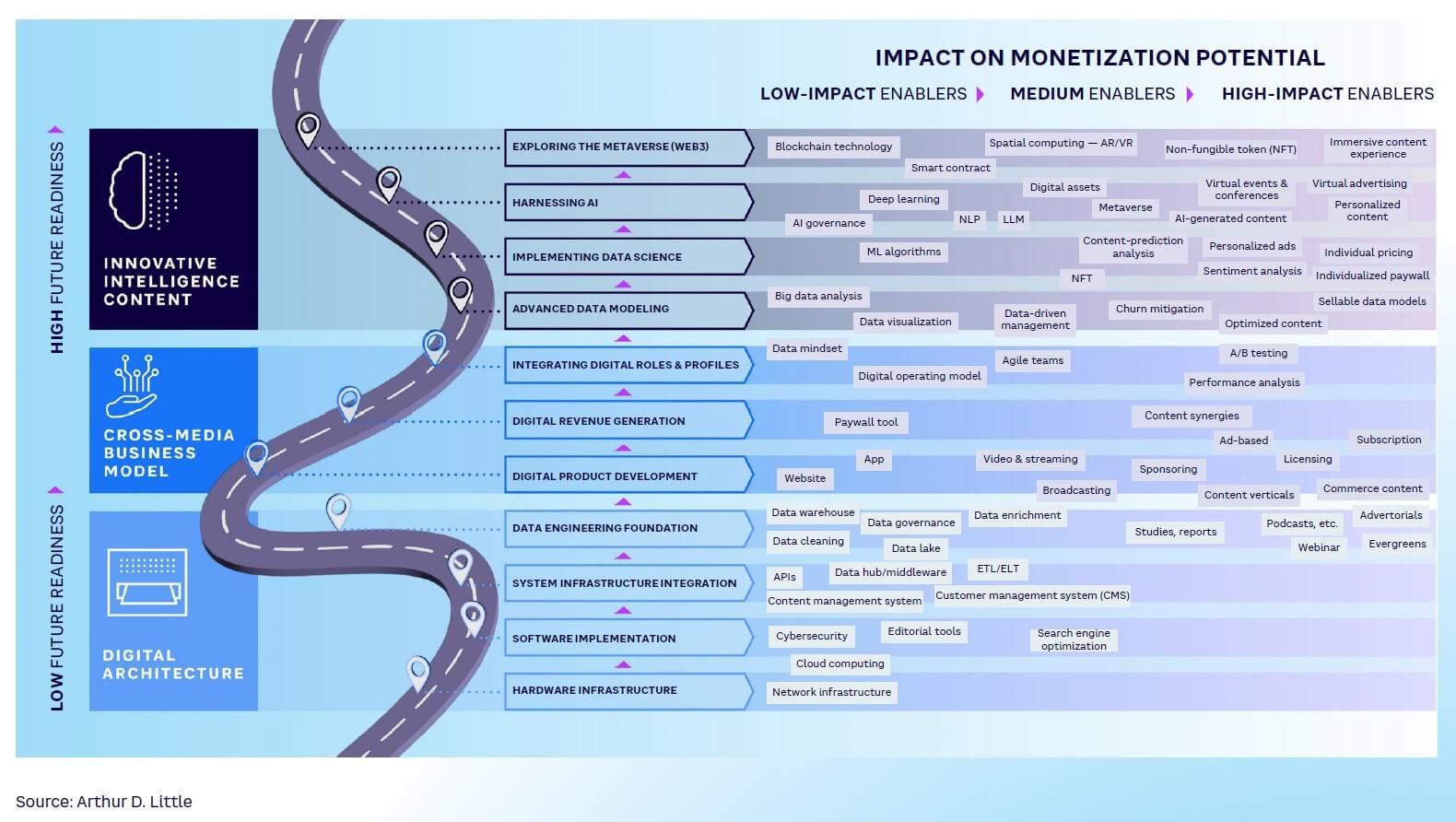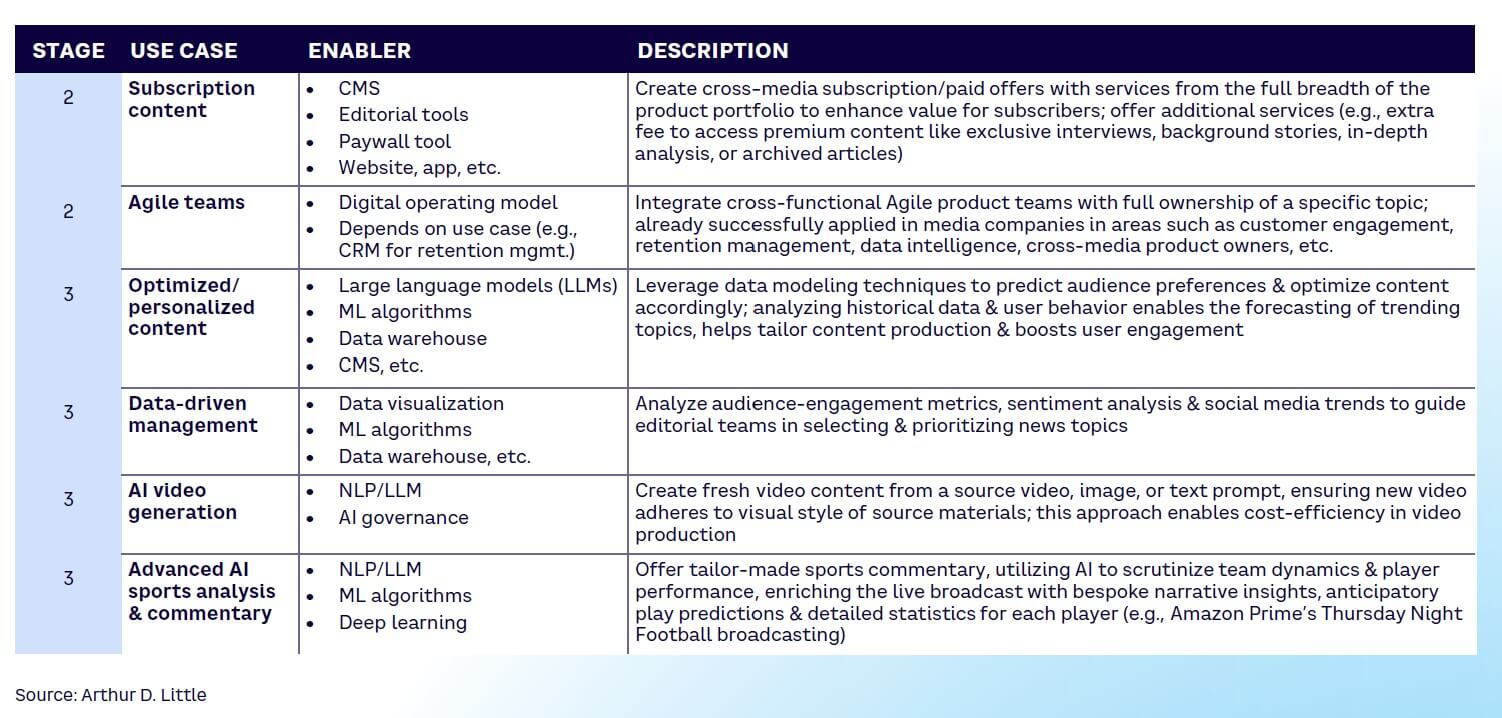
DOWNLOAD
DATE
Contact
With the recent ascent of artificial intelligence (AI), we find ourselves on the threshold of a new era, one that opens even greater opportunities for content creation and generation. However, many publishers and media companies are not yet equipped with the necessary prerequisites to fully leverage AI and its varied applications. The transition from print to a digital-first and then a digital-only strategy necessitates a complete reevaluation of fundamental principles governing successful media and publishing enterprises. In particular, companies heavily dependent on print or other declining business models must now strategically reinvest in the transition toward a digital-first strategy while previous business models still generate profits.
Central to unlocking the full potential of a future-ready, digital-only strategy is the necessity for a resilient technological foundation that leverages existing products and synergies but also enables high-impact use cases. To provide direction along this transition, Arthur D. Little (ADL) has developed a Digital Media and Publishing Roadmap (see Figure 1). This roadmap offers a strategic framework that starts with the basic technical requirements and progresses through various phases to ultimately build a technologically future-oriented foundation. It serves the dual purpose of helping publishers assess their current standing and showcasing the range of evolving use cases, each contributing incrementally to content monetization along the journey.

ASSESS, ADAPT & THRIVE
At its core, the Digital Media and Publishing Roadmap outlines a journey to prepare publishers and media companies for a future-ready landscape. It’s important to recognize that each company’s starting point may differ, depending on existing IT infrastructure, but the following sets the stages:
-
Stage 1 — Digital architecture. The roadmap begins with essential baseline requirements, such as establishing a robust digital architecture that entails tailored software implementations and sound data engineering foundations (see Figure 1, bottom).
-
Stage 2 — Cross-media business model. Once the initial investments in technical capabilities are in place, the roadmap continues toward laying the groundwork for a cross-media business model. This stage includes activities such as digital product development, digital revenue-generation strategies, and the integration of digital roles and profiles (see Figure 1, center).
-
Stage 3 — Innovative intelligence content. The final stage of this roadmap entails the integration of innovative and intelligent solutions. This encompasses advanced data modeling, harnessing the power of AI and capitalizing on emerging opportunities within the Metaverse (see Figure 1, top).
These three segments of the roadmap serve as building blocks for future progress, ultimately leading to a diverse array of monetizable use cases. For publishers and media companies, this serves as an initial benchmark to assess their current state of readiness and offers a clear path to bridge any existing gaps.
FROM GROUNDWORK TO PROFIT
Quickly build technological foundations, enable relevant products & better monetizable use cases
The roadmap’s value lies in its ability to connect each step with corresponding technological enablers, thereby highlighting the entire spectrum of potential use cases for content monetization and their degree of impact. This holistic view shows that true economic benefits are realized toward the end of the roadmap (see Figure 1, top-right), when the number and impact of use cases related to content monetization increase. Early-stage technical enablers (see Figure 1, bottom-left) may initially offer limited use cases with modest content-monetization potential. At this stage, their primary role focuses on laying the essential foundations upon which more impactful content-monetization enablers and use cases can be constructed.
Progressing along the roadmap, from bottom-left to top-right, is essential for publishers and media companies to achieve a relevant, digital, and highly monetizable product portfolio — a state of future readiness. For instance, creating a robust customer management system (CMS), coupled with a data warehouse that enriches and cleanses data, provides the groundwork for efficient utilization of content-monetization enablers, such as advertorials, commerce content, and subscription-based models on websites.
As the journey unfolds, both execution and monetization opportunities improve vastly. Use cases such as content-prediction analysis, sentiment analysis, and personalized content are highly driven by big data analysis and machine learning (ML) algorithms, which ideally have been implemented at an earlier stage (see Table 1 for use case examples).
The key takeaway is that publishers and media companies that construct a strong technological foundation and progress along the roadmap gain a significant competitive advantage. Their potential for high-impact content monetization far surpasses that of companies that skip essential stages or fail to advance along the roadmap. Failing to do so risks being left behind as the ladder of developments and new use cases consistently ascends to new heights.

FOLLOW THE ROAD
The Digital Media and Publishing Roadmap enables companies to assess their technological foundation and provides guidance on how to leverage innovative use cases. Many media businesses’ technology stacks are not where they should be at the beginning of 2024. Neglecting development and future-proofing of digital foundations over the past decade are taking its toll on the current environment. With the advent of new technological milestones (e.g., generative AI), companies are struggling to keep pace and successfully monetize advanced use cases.
Here is where ADL’s Digital Media and Publishing Roadmap serves as a pragmatic guide for the present and future:
-
Utilize the ADL roadmap for strategic positioning and guidance. Depending on individual circumstances, publishing companies can locate themselves within the roadmap, assess their technological foundation, and identify strategic development paths toward unlocking the full potential of content monetization.
-
Reach cross-media synergies by holistically bridging the technological gap. Catching up on technological foundations will enable many publishers and media companies to effectively implement new use cases and realize the long-anticipated cross-media synergies and audience engagements.
-
Leverage innovative content technologies. To fully exploit emerging monetization opportunities (at the top of the roadmap) and enable growth and distinction in a highly competitive market, media companies should incorporate advanced technologies, such as AI-driven content, Metaverse-like platforms, or personalized content delivery.






